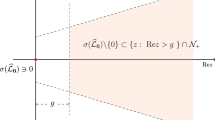Abstract
A new class of models describing the dissipative dynamics of an open quantum system S by means of random time evolutions of pure states in its Hilbert space ℋ is considered. The random evolutions are linear and defined by Poisson processes. At the random Poissonian times, the wavefunction experiences discontinuous changes (quantum jumps). These changes are implemented by some non-unitary linear operators satisfying a locality condition. If the Hilbert space ℋ of S is infinite dimensional, the models involve an infinite number of independent Poisson processes and the total frequency of jumps may be infinite. We show that the random evolutions in ℋ are then given by some almost-surely defined unbounded random evolution operators obtained by a limit procedure. The average evolution of the observables of S is given by a quantum dynamical semigroup, its generator having the Lindblad form.(1) The relevance of the models in the field of electronic transport in Anderson insulators is emphasised.
Similar content being viewed by others
REFERENCES
G. Lindblad, Comm. Math. Phys. 48:119 (1976).
H. Spohn, Large Scale Dynamics of Interacting Particles (Springer-Verlag, 1991).
P. Drude, Ann. Physik 1:566 (1900).
H. Schulz-Baldes, Phys. Rev. Lett. 77:2176 (1997).
P. W. Anderson, Phys. Rev. 109:1492 (1958).
J. Dalibard, Y. Castin, and K. Mølmer, Phys. Rev. Let. 68:580 (1992); K. Mølmer, Y. Castin, and J. Dalibard, J. Opt. Soc. Am. B 10:524 (1993).
H. Carmichael, An Open System Approach to Quantum Optics (Lecture Notes in Physics m18, Springer-Verlag, 1991).
G. C. Ghirardi, A. Rimini, and T. Weber, Phys. Rev. D 34:470 (1986).
N. Gisin and I. C. Percival, J. Phys. A: Math. Gen. 25:5677 (1992) and references therein.
G. C. Ghirardi, P. Pearle, and A. Rimini, Phys. Rev. A 42:78 (1990).
A. Barchielli and V. P. Belavkin, J. Phys. A: Math. Gen. 24:1495 (1991).
V. P. Belavkin, J. Phys. A.: Math. Gen. 22:L1109 (1989).
F. Haake, Statistical Treatment of Open Systems by Generalized Master Equations, Springer tracts in modern physics Vol. 66 (Springer-Verlag, 1973).
S. Nakajima, Progr. Theor. Phys. 20:948 (1958); R. Zwanzig, J. Chem. Phys. 33:1338 (1960).
E. B. Davies, Commun. Math. Phys. 39:91 (1974).
V. Gorini and A. Kossakowski, J. Math. Phys. 17:1298 (1976).
H. Spohn, Rev. Mod. Phys. 53:569 (1980).
J. V. Pulé, Commun. Math. Phys. 38:241 (1974).
K. Hepp and E. H. Lieb, Helv. Phys. Acta 46:573 (1973).
N. G. van Kampen, Stochastic Processes in Physics and Chemistry, second edition (North-Holland, 1992).
W. T. Strunz, Phys. Lett. A 224:25(1996).
L. Diósi and W. T. Strunz, Phys. Lett. A 235:569 (1997).
L. Diósi, N. Gisin, and W. T. Strunz, Phys. Rev. A 58:1699 (1998); W. T. Strunz, L. Diósi, and N. Gisin, Phys. Rev. Lett. 82:1801 (1999).
M. O. Caceres and A. K. Chattah, Physica A 234:322 (1996).
J. Bellissard, A. van Elst, and H. Schulz-Baldes, J. Math. Phys. 35:5373 (1994).
H. Schulz-Baldes and J. Bellissard, J. Stat. Phys. 91:991 (1998).
H. Schulz-Baldes and J. Bellissard, Rev. Math. Phys. 10:1 (1998).
M. B. Plenio and P. L. Knight, Rev. Mod. Phys. 70:101 (1998).
A. Einstein, Phys. Zeits 18:121 (1917).
B. I. Shklovskii and A. L. Efros, Electronic Properties of Doped Semiconductors (Springer-Verlag, 1984).
See M. Aizenman and S. Molchanov, Commun. Math. Phys. 157:245-278 (1993) and references therein.
N. F. Mott, J. Non-Crystal. Solids 1:1 (1968).
W. Mason, S. V. Kravchenko, G. E. Bowker, and J. E. Furneaux, Phys. Rev. B 52:7857 (1995); S. I. Khondaker, I. S. Shlimak, J. T. Nicholls, M. Pepper, and D. A. Ritchie, Phys. Rev. B 59:4580 (1999).
G. Ebert, K. von Klitzing, C. Probst, E. Schuberth, K. Ploog, and G. Weimann, Solid State Comm. 45:625(1983).
J. Delahaye, J. P. Brison, and C. Berger, Phys. Rev. Lett. 98:4204 (1998).
D. Spehner, Ph.D. Thesis, (Université Paul Sabatier, Toulouse, France, 2000).
A. Miller and E. Abrahams, Phys. Rev. 120:745 (1960).
I. N. Kovalenko, N. Y. Kuznetsov, and V. M. Shurenkov, Models of Random Processes: A Handbook for Mathematician and Engineers (CRC press, 1996).
M. Reed and B. Simon, Methods of Modern Mathematical Physics, vol. 1-4 (Academic Press, 1975).
K. Kraus, Ann. Phys. 64:311 (1971); K. Kraus, Comm. Math. Phys. 16:142 (1970).
E. B. Davies, Quantum Theory of Open Systems (Academic Press, 1976).
W. F. Stinespring, Proc. Am. Math. Soc. 6:211 (1955).
J. Bellissard, in From Number Theory to Physics, Springer Proceedings in Physics vol. 47, J. M. Luck, P. Moussa, and M. Waldschmidt, eds. (Springer-Verlag, Berlin, 1990).
O. Bratteli and D. W. Robinson, Operator Algebras and Quantum Statistical Mechanics, vol. 1 (Spinger-Verlag, 1987).
A. Kossakowski, Rep. Math. Phys. 3, 247 (1972).
E. B. Davies, J. Funct. Analysis 34, 421 (1979).
C. Cohen-Tannoudji, J. Dupond-Roc, and G. Grynberg, Atom-Photon Interactions: Basic Processes and Applications (Wiley, New-York, 1992).
D. R. Grempel, R. E. Prange, and S. Fishman, Phys. Rev. A 29:1639 (1984).
D. Giulini, E. Joos, C. Kiefer, J. Kupsch, I.-O. Stamatescu, and H. D. Zeh, Decoherence and the Appearance of the Classical World in Quantum Theory, chap. 8 (Springer-Verlag, 1996).
J. S. Bell, Speakable and Unspeakable in Quantum Mechanics (Cambridge University Press, 1987).
D. Spehner and J. Bellissard, to be published in: Proceedings of the International Conference on Quantum Optics of Santiago, Chile, August 2000, Lecture Notes in Physics, M. Orszag and J. C. Retamal, eds. (Springer-Verlag, 2001).
J. Bellissard, R. Rebolledo, D. Spehner, and W. von Waldenfels, in preparation
Author information
Authors and Affiliations
Rights and permissions
About this article
Cite this article
Spehner, D., Bellissard, J. A Kinetic Model of Quantum Jumps. Journal of Statistical Physics 104, 525–572 (2001). https://doi.org/10.1023/A:1010320520088
Issue Date:
DOI: https://doi.org/10.1023/A:1010320520088



